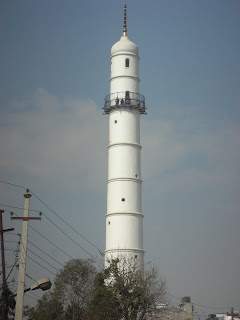

The tower was originally built in 1826 for Queen Lalit. It was severely damanged in the 1934 earthquake, and was rebuilt two stories less than the original (not sure why). There are 213 steps inside (in a very narrow wind), and 188 take you to the viewing tower where you can look out over the city.


After visiting the Tower, we continued on our walking adventure out to Swayambhunath, also known as the “Monkey Temple.” The compound is located on a hill that towers high above Kathmandu, slightly to the west of the city. It combines both Buddhist and Hindu religion, peacefully, in one location. According to legend, the Kathmandu Valley was once a lake (which has been supported by geological evidence), out of which the Swayambhunath hill arose spontaneously; therefore, the name swayambhu means “self-arisen.” The name suits it well, as the only way to “arise” to the Temple is to do it yourself. In order to get to the giant Stupa, you have to ascend many, many stairs. Too many to count. But the view from the top is well worth the difficult venture up the hill.

On the trek up to the Temple, one can see where the “Monkey Temple” received it’s names. There are lots of rhesus macaques playing around on the stairs. These monkeys are more-than-eager to accept any type of food that is offered (or often times not offered) to them.

 Once at the top of the stairs, there is so much to take in; but it is difficult to take your eyes away from the main attraction, the Swayambhunath Stupa. From the top, four faces of the Buddha look out across the Kathmandu Valley, with each face staring in the four different cardinal directions. The squiggle below the eyes is the Nepali number ek (one), signifying unity. The third eye signifies the insight of the Buddha. The white dome represents the earth, and the 13-tiered structure beneath the dome represents the 13 stages that one must pass through to achieve nirvana.
Once at the top of the stairs, there is so much to take in; but it is difficult to take your eyes away from the main attraction, the Swayambhunath Stupa. From the top, four faces of the Buddha look out across the Kathmandu Valley, with each face staring in the four different cardinal directions. The squiggle below the eyes is the Nepali number ek (one), signifying unity. The third eye signifies the insight of the Buddha. The white dome represents the earth, and the 13-tiered structure beneath the dome represents the 13 stages that one must pass through to achieve nirvana. 


The base of the stupa is ringed by Buddhist prayer wheels, which are embossed with the mantra om mani padme hum (“hail to the jewel in the lotus”). These prayer wheels are spun by visitors and pilgrims alike, as they wander around the stupa (ALWAYS wandering in the clockwise direction).

After taking in the sites for a bit, we headed back to our Guesthouse to relax for the night and plan our next adventures…

No comments:
Post a Comment